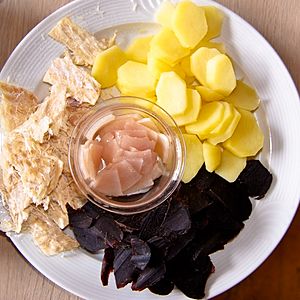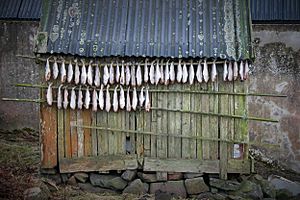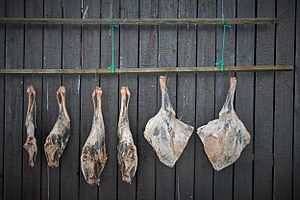Faroese cuisine facts for kids
The Faroe Islands are a group of islands in the North Atlantic Ocean. The food here is very special because it uses what's available nearby. Important parts of Faroese cuisine are lamb and fish, since the islands are surrounded by the sea.
Traditional foods from the Faroe Islands include skerpikjøt (a type of dried lamb meat), fresh seafood, whale meat, blubber (whale fat), and puffins. People also eat potatoes and a few fresh vegetables.
Much of the unique taste of this traditional food comes from how it's kept fresh. Methods like using salt water (brine), drying, and letting meat and fish mature are very common. This maturing process is called ræstkjøt for meat and ræstur fiskur for fish.
For a long time, food from animals was the most important part of Faroese meals. However, tastes have changed over the years, becoming more like what people eat in Europe. People now eat a lot more vegetables than they used to, and less fish. Fresh and matured lamb meat is still very popular. But some older traditional meat products, like certain sausages, are not as popular with younger people today.
Contents
Types of Food in the Faroe Islands
Fish Dishes
Fish is a big part of Faroese meals because the islands are in the North Atlantic Ocean. You can find fresh fish all year round! Islanders often eat haddock, plaice, halibut, herring, and shrimp.
Meat Dishes
For a long time, the main source of meat was the domestic Faroese sheep. These sheep were also important for their wool. One of the most popular treats is skerpikjøt. This is lamb meat that has been aged well and dried by the wind. It can be quite chewy! Many Faroese homes, especially in smaller towns and villages, have a special drying shed called a hjallur. This is where they hang the meat to dry. Other traditional foods include ræst kjøt (lamb meat that is partly dried) and ræstur fiskur (fish that has been matured).
Game Meat
Small game animals in the Faroe Islands are mostly seabirds.
Whale Meat and Blubber

Another special Faroese dish is tvøst og spik. This is meat and blubber (fat) from pilot whales. The meat and blubber can be kept fresh and prepared in different ways. Often, they are cut into long, thin slices called likkjur and hung up to dry. These dried slices are often part of a "cold table" (kalt borð). This table has many different cold Faroese and international dishes. The Faroese dishes on a cold table can include whale meat, whale blubber, dried fish, and dried lamb meat like skerpikjøt. The cold table is often served at special parties.
Whale meat can also be boiled or, more recently, fried like steaks. There are also two ways to salt whale meat: using dry salt or keeping it in salty water (saltlakað grind). Boiled potatoes are usually eaten with whale meat and blubber. This tradition is not very old, as potatoes only became common in the Faroe Islands in the 1800s.
Scientists have studied pilot whale meat and blubber because of certain substances found in the ocean. Health experts have given advice about how much whale meat and blubber people should eat. For example, the Faroese Food and Veterinary Agency suggested in 2011 that people should eat whale meat and blubber no more than once a month. They also advised that the kidneys and liver of the whale should not be eaten at all because they contain more of these substances. They also recommend that women who are pregnant or planning to become pregnant should avoid eating whale meat and blubber.
Imported Foods
Even though there are twice as many sheep as people in the Faroe Islands, fresh local lamb meat is not usually sold in supermarkets. Most sheep belong to families who keep the meat for themselves. Some farmers with larger flocks do sell meat privately or to restaurants and supermarkets, but this is often dried lamb, not fresh.
There are no pigs raised in the Faroe Islands, but pork is very popular, so it is imported, mostly from Denmark. Some farmers have cattle, but mostly for milk. Veal (meat from young cows) is imported. Chicken and turkey are also imported. Most of the food you find in supermarkets comes from other countries. Milk and yogurt are made in the Faroe Islands, but cheese is imported. Fruits and vegetables come from various countries. Sometimes, you can buy Faroese-grown potatoes and rutabaga. Eggs are imported from Denmark and Sweden. In 2011, the Faroe Islands imported a lot of food, drinks, and tobacco.



